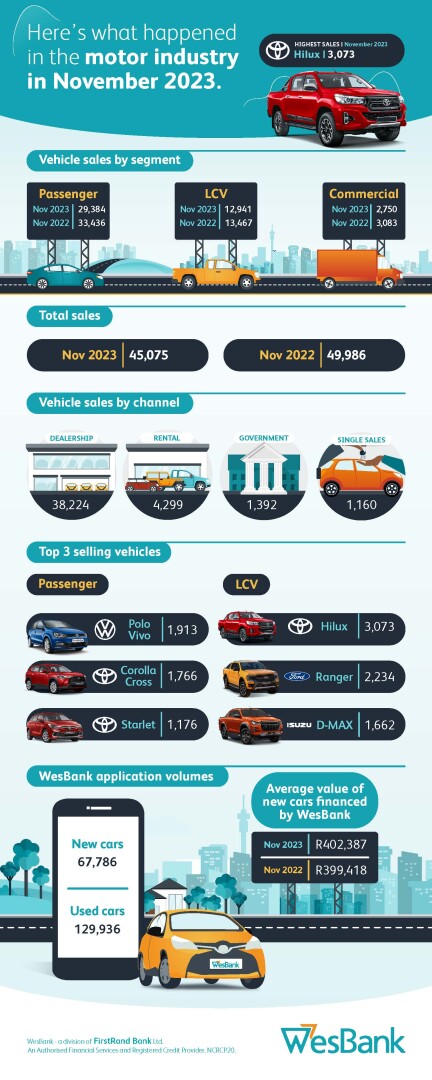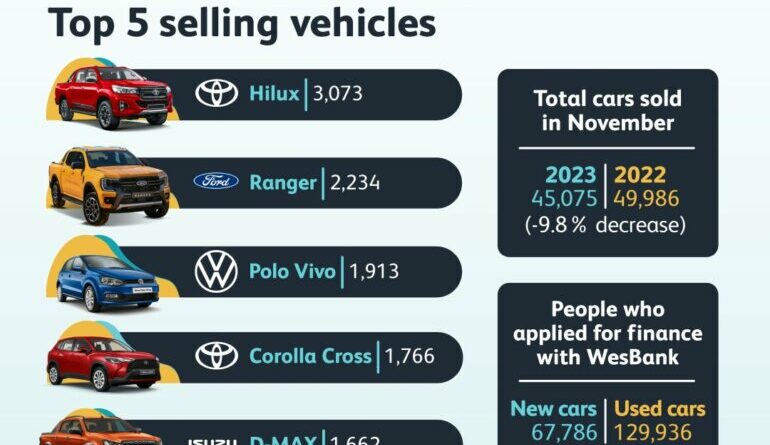New vehicle sales strain
New vehicle sales bore their biggest losses during November since the beginning of 2021 when the market was beginning its slow recovery from the COVID-19 pandemic. According to figures released by naamsa | the Automotive Business Council, SA’s new vehicle sales fell a significant 9.8% year-on-year to 45,075 units in November, the sixth month of declining sales this year, and the fourth consecutive month of negative growth.
The market could have found some consolation in the fact that November sales were in the median range of 2023 volumes. They were also only 385 units less than October sales. But year-to-date growth has softened substantially to 0,8%, confirming the economic challenges that face motorists and the motor industry.
Consumers had their third respite from further interest rate increases in November when the South African Reserve Bank held interest rates unchanged. But the general outlook remains for a high interest rate environment to continue impacting household debt until the middle of next year.
“While this is of some comfort to indebted consumers, the high lending rate combined with high inflation and relatively lower household income, will continue to restrict big-ticket purchases such as new vehicles,” says Lebo Gaoaketse, Head of Marketing and Communication at WesBank.
The volatility of the energy crisis also continues to weigh on consumer and business confidence. “Those restricted household incomes and business revenue streams are prioritizing an alternative energy solution before a new vehicle purchase,” says Gaoaketse. “With the return of higher stages of loadshedding during November, sales during December and January could be expected to experience a higher-than-usual wait-and-see approach to purchase decisions.”
Whilst WesBank’s application rate increased during November, this obviously didn’t translate into sales. “More insightful is the significant increase in applications for used vehicles, which out-number new vehicle applications two-to-one,” says Gaoaketse. “This is also reflected in a year-on-year increase of financed vehicles at the bank in favour of used vehicles, WesBank’s ratio now sitting at 1.92 used vehicles financed for every new vehicle.”
This increase in used vehicle interest is one impacting factor for new vehicle sales during the past four months of declines. “Year-on-year increases in deal duration (how long customers hold onto their vehicle for) and contract period (the length of the finance agreement with the bank) both indicate a constrictive environment to new vehicle purchases,” says Gaoaketse. “This is driven by affordability of instalments in the monthly household budget and the uncertainty of the myriad of socio-political headwinds facing consumers.”
Not all the impacts are from the purchasing side of the counter, however. Logistical disruptions during the month will have had – and continue to have – impacts on supply, limiting motor companies’ abilities to conclude deals. The industry’s concern will be the potential ramifications across the value chain going into the new year.
All segments of the market showed losses during November. Passenger car sales declined 12.1% to 29,384 units – a considerable 4,052 fewer sales than the same month last year. The traditionally more buoyant Light Commercial Vehicle market fared the best amongst the losses, down 3.9% to 12,941 units.
“The consideration will now be whether the new vehicle market can show any growth at all in 2024, depending on what December sales contribute to the annual volume,” says Gaoaketse. “But relative to the headwinds that have faced the economy and market this year, volumes hovering towards the mid-40,000 sales mark continue to provide opportunity to consumers, dealers, and the brands themselves.”

The long-expected downturn in vehicle sales in South Africa materialises https://t.co/aow7NRNtHP #ArriveAlive #VehicleSales #NADA @dealerfloor pic.twitter.com/08v7oa4J0S
– Arrive Alive (@_ArriveAlive) December 2, 2023




